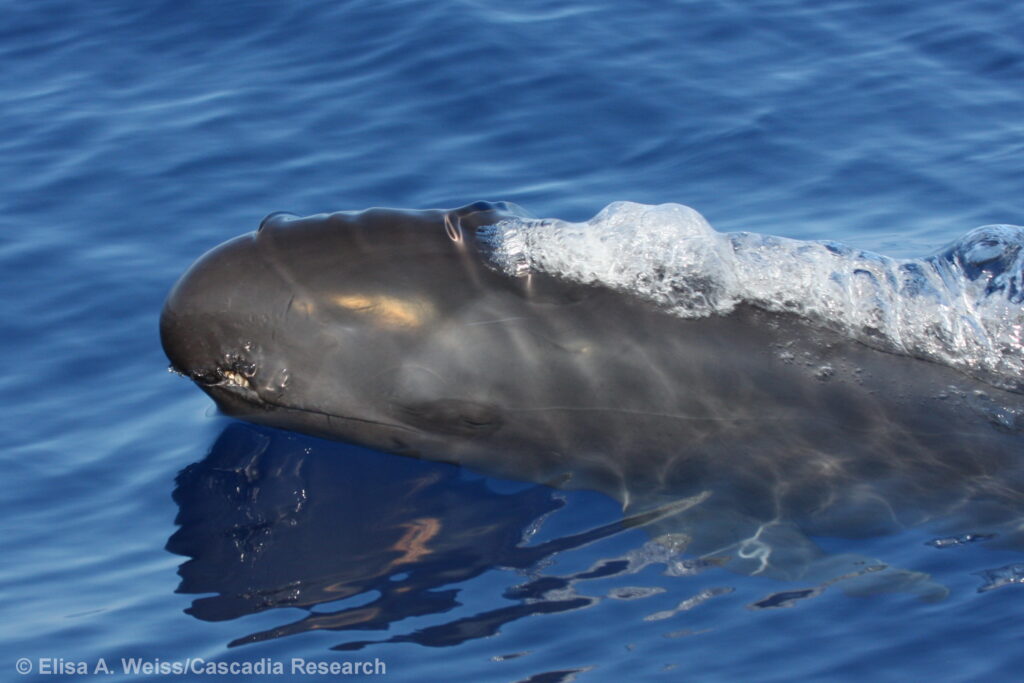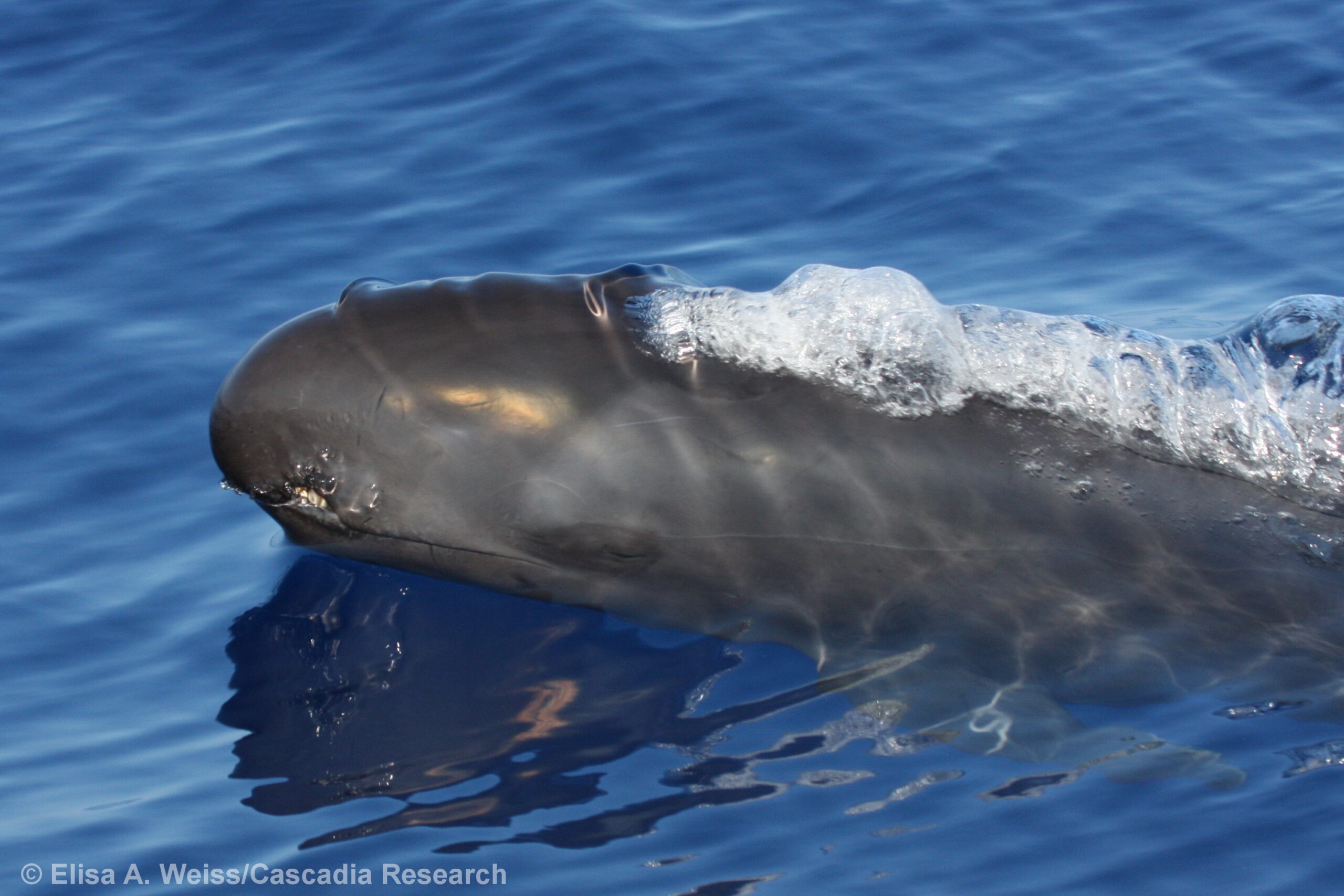What is driving down the population of false killer whales around the Main Hawaiian Islands?
A paper just published in the journal Endangered Species Research suggests that the fishing activities of thousands of commercial and recreational fishers operating in nearshore waters may be responsible. At the very least, it almost certainly has made a non-trivial contribution to the decline of the endangered MHI population of false killer whales, which now numbers around 139 individuals. That’s more than a 50 percent decline since the late 1980s. The population continues to fall at the rate of 3.5 percent a year.
The Honolulu-based fleet of around 150 longline vessels that fish for bigeye tuna engages with false killer whales, but almost all of those animals belong to the pelagic FKW population. For the last 30 years, the ocean from shore out to 50 nautical miles has been off-limits to longliners, which makes the likelihood of longline vessels hooking a false killer whale from the MHI population unlikely (although it does rarely occur).
Estimating the rate of interaction between the longliners and pelagic population has been based on reports from human observers, placed on a certain percentage of vessels at sea at a given time. In the past, about one in five vessels carried observers, but that percentage has declined recently, to the point that for this year, it is anticipated to be no more than 7 percent.
The interactions of the nearshore fishing vessels with the MHI population of false killer whales lack even that level of monitoring. But there is a photographic record, going back more than 20 years, that the authors of the recent scientific paper have mined to determine the extent and severity of harm caused by the nearshore fishing vessels to the MHI false killer whales.
The photographs that show injuries to dorsal fins and mouthlines support the finding that 28.7 percent of individuals in the MHI population have interacted with nearshore fishing vessels. Among the animals showing dorsal fin injuries, females were much more likely to have evidence of such injuries (17.4 percent) than males (5.3 percent).
“Such injuries, typically to the leading edge of the dorsal fin, presumably originate when an animal is hooked in the mouth and struggles against the taut line,” the study says, “although injuries to other areas of the body can also occur if an animal becomes entangled during the process.”

But the photos show only the survivors, notes Robin Baird, one of the authors of the paper who practically pioneered the close study of false killer whales in waters around Hawaiʻi. “We are definitely only getting photos of those that survive fishery interactions,” Baird stated in comments to Environment Hawaiʻi. “I’m sure there are many that are not surviving. In addition, some of those that we are getting photos of could still have ingested hooks that may eventually kill them.”
Baird noted that a study of bottlenose dolphins showed that the animals that ingested gear often died later.
“In the case of the longline fishery, about 85 percent of the observed interactions either result in death or serious injury,” he said. “I suspect the rate is much lower for the lighter gear that is used around the Main Hawaiian Islands, but obviously we don’t know what the rate is.”
Overall, he said, “I think that fisheries interactions are the most likely cause of the decline in the population since 2013.”
All three of the false killer whale populations in Hawaiian waters – the Northwestern Hawaiian Islands population, the pelagic population, and the MHI population – enjoy protection under the federal Marine Mammal Protection Act. The MHI population, which is critically endangered, is also protected under the federal Endangered Species Act.
The longline fleet cannot legally fish inside of 50 miles of the Main Hawaiian Islands, which effectively prevents it from interacting with the MHI population. Nor can it fish in the Papahanaumokuakea Marine National Monument, which protects the NWHI population of false killer whales. The presence of observers monitoring interactions with the pelagic population, as well as sanctions should the number of animals seriously injured or killed by interactions with fishing gear reach a certain level, means that the pelagic population has some protection.
But the non-longline commercial vessels that fish in Hawaiian waters, in addition to hundreds of recreational fishers, are not monitored. Nor is there any rule, federal or state, that requires them to adopt gear or accept observers to monitor interactions with animals belonging to the Main Hawaiian Island population.
“Observer coverage over most of the range of the endangered MHI stock – the population with the highest rates of injuries consistent with fisheries interactions – is nonexistent, which creates a barrier to understanding the full extent of risk that fisheries pose to the declining population,” the authors of the paper write.
They suggest some form of monitoring be adopted, including electronic monitoring. So far, they note, “fisheries-related efforts have been limited to outreach and education, providing information to help fishers discriminate between false killer whales and other similar species … and encouraging fishers to move out of the area when false killer whales are present.
“In spite of these efforts, we have demonstrated that fisheries interactions are ongoing for the endangered MHI population and a large proportion of the population appears to interact with fishing gear.”
The authors note that the measures adopted for the deep-set longline fishery have been largely ineffective, and that, given the wide variety of fishing methods used by nearshore fisheries, adopting effective measures to reduce interactions with false killer whales is even more complex.
“Novel targeted measures should be developed to either effectively reduce the rate of interactions or reduce the likelihood of injury or mortality, ideally through collaborative efforts with stakeholder communities,” they conclude.
(The study, “False killer whales and fisheries in Hawaiian waters: evidence from mouthline and dorsal fin injuries reveal ongoing and repeated interactions,” was published December 12 in Endangered Species Research. Authors are Annette Harnish, Robin Baird, Sabre Mahaffy, Annie Douglas, Michaela Kratofil, Jacquelyn Shaff, Tori Cullins, Stephanie Stack, Jens Currie, and Amanda Bradford.)
***
Electronic Monitoring
For Longline Fleet
As noted above, the rate of observer coverage for longline vessels in the Hawaiʻi fleet has dropped, from an average of around 20 percent, to around 17 percent, then 13 percent in 2024, and 7 percent in 2025. The National Marine Fisheries Services cites budgetary constraints in its efforts to explain the cuts, which come close to the minimum level of 5 percent required by the Western and Central Pacific Fishery Management Commission, the international organization that governs fishing in most of the region fished by the Hawaiʻi fleet.
Instead of human observers, now the push is to adopt systems of electronic monitoring. Yet this, too, is expected to be costly.
At the meeting of the Western Pacific Fishery Management Council’s Scientific and Statistical Committee last month, T. Todd Jones, representing the Pacific Islands Fisheries Science Center, said that adoption of electronic monitoring systems fleet-wide would cost more than $2 million. By 2026, he said, it is hoped that some system will have been installed on some of the boats. By 2027, full fleet coverage is expected to occur.
But no matter the cost, don’t expect the fishers to pay. Eric Kingma, executive director of the Hawaiʻi Longline Association, told the group that longliners are hurting economically. “Profitability is the lowest it has been in the last 20 years in the industry,” he said. “You wouldn’t get any vessels to sign up if they had to pay for it.”
— Patricia Tummons


Mikesur808@gmail.com
l had a commercial fisheries license for 40 plus years. never had or seen any of this? is someone trying to make a job for them self??